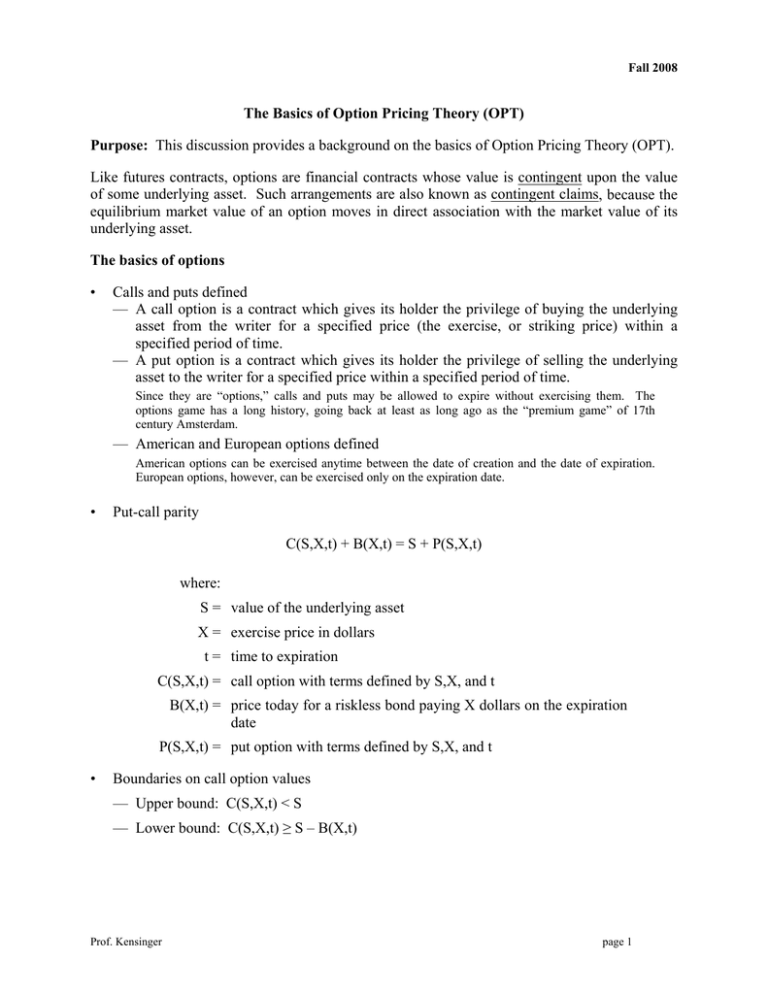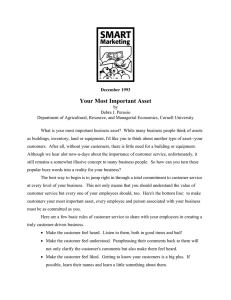The Basics of Option Pricing Theory (OPT) Purpose:
advertisement

Fall 2008 The Basics of Option Pricing Theory (OPT) Purpose: This discussion provides a background on the basics of Option Pricing Theory (OPT). Like futures contracts, options are financial contracts whose value is contingent upon the value of some underlying asset. Such arrangements are also known as contingent claims, because the equilibrium market value of an option moves in direct association with the market value of its underlying asset. The basics of options • Calls and puts defined — A call option is a contract which gives its holder the privilege of buying the underlying asset from the writer for a specified price (the exercise, or striking price) within a specified period of time. — A put option is a contract which gives its holder the privilege of selling the underlying asset to the writer for a specified price within a specified period of time. Since they are “options,” calls and puts may be allowed to expire without exercising them. The options game has a long history, going back at least as long ago as the “premium game” of 17th century Amsterdam. — American and European options defined American options can be exercised anytime between the date of creation and the date of expiration. European options, however, can be exercised only on the expiration date. • Put-call parity C(S,X,t) + B(X,t) = S + P(S,X,t) where: S = value of the underlying asset X = exercise price in dollars t = time to expiration C(S,X,t) = call option with terms defined by S,X, and t B(X,t) = price today for a riskless bond paying X dollars on the expiration date P(S,X,t) = put option with terms defined by S,X, and t • Boundaries on call option values — Upper bound: C(S,X,t) < S — Lower bound: C(S,X,t) ≥ S – B(X,t) Prof. Kensinger page 1 Fall 2008 Keys for using OPT as an analytical tool • The response of call option values to ceteris paribus changes in five basic underlying variables 1. value of the underlying asset 2. exercise price 3. risk-free interest rate 4. time to expiration 5. volatility of returns on the underlying asset Black-Scholes Option Pricing Model C(S,X,t) = SN(d1) – Xe–rt N(d2) where: d1 = [ln(S/Xe–rt) / s√t ] + 0.5 s √t d2 = [ln(S/Xe–rt) / s √t ] – 0.5 s √t N(…) = Normal probability density function (NORMDIST on the Excel function menu) Implied Volatility When one knows the option premium, one can use a search routine to find the volatility that is implied. Let’s use the option calculator software to solve an example. Suppose the stock price is $52, the exercise price is $50, the t-bill rate is 5%, and the time remaining to expiration is half a year. Suppose we know that the premium for the call option is $5 per share. Let’s make an initial guess of 16% for the standard deviation of the underlying stock. When we enter that in the option calculator, we find a call premium of $4.25, so we know the first guess is too low. Next, let’s try a revised guess of 25% for the standard deviation. When we enter that in the option calculator, we find a call premium of $5.20, so we know the first guess is too high. Next, let’s try a revised guess of 22% for the standard deviation. When we enter that in the option calculator, we find a call premium of $5.00, so we have found the implied volatility. Standardizing Options One can standardize a group of options in order to make comparisons and search for potential arbitrage opportunities. To do so, we simply divide the stock price by the exercise price, creating an option with an exercise price of one. Then the value of the underlying asset is adjusted to S/X. Time and volatility stay the same, as follows: Prof. Kensinger page 2 Fall 2008 C(S/X,1,t) = [S/X] N(d1) – e–rt N(d2) where: d1 = [ln(S/Xe–rt) / s√t ] + 0.5 s √t d2 = [ln(S/Xe–rt) / s √t ] – 0.5 s √t Margrabe Model Option to exchange one asset for another: In the case of a call option, the choice is to give up the second asset in order to receive the first asset. In the case of a put option, the choice is to give the first asset and receive the second asset. C(X1,X2,t) = X1N(d1) – X2N(d2) where: X1= The first asset X2= The second asset d1 = [ln(X1,X2) / sR √t ] + 0.5 sR √t d2 = [ln(X1,X2) / sR √t ] – 0.5 s R √t s R2= Variance of the ratio of asset values = ss2– 2ss2r2 s= Standard deviation of returns for asset 1 s2= Standard deviation of returns for asset 2 N(…) = Normal probability density function (NORMDIST on the Excel function menu) Basic option strategies 1. long call 2. short call 3. long put 4. short put 5. long straddle 6. short straddle 7. box spread Prof. Kensinger page 3




